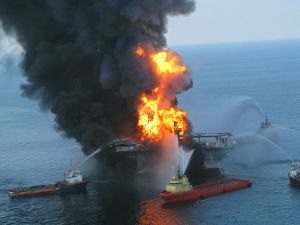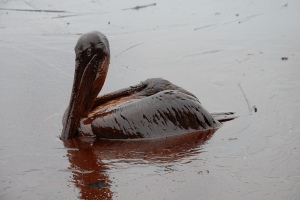The Deepwater Horizon disaster is considered to be the largest marine oil spill in history, turning vast swathes of the southern US coast into tar pits, and helpless marine critters into bewildered balls of bitumen.
“But what of the poor bacteria?” I hear absolutely nobody cry. Well it turns out some people are interested in the microorganisms that populate these beaches – for one thing they form an important part of the wider ecosystem.
A new study by US scientists looks at how populations of microorganisms have been affected, with certain types of bacteria seemingly replaced by others, and suggests that not only the slick itself, but also the clean-up operation have played a role in this ecological shift.
So, what’s the point?
Deepwater Horizon was a floating oil rig based in the Gulf of Mexico. On April 20th, 2010 an explosion on the rig killed 11 workers and resulted in the catastrophic leakage of oil into the sea. The leak was not properly stemmed until around three months later, by which time around 90-180 million US gallons of oil were thought to have spilled into the Gulf of Mexico.
While most of the attention of the media regarding the environmental impact of the disaster was focused on oil-drenched photogenic animals, less-glamorous organisms were also affected. The ecosystems that exist on sandy beaches are diverse and complex, and the tiniest creatures – microorganisms – form a vital cog of these systems.
So in order to understand the full effects of the disaster, figuring out what has happened to the microorganisms is key – and this study sets out to do precisely that.
But they weren’t just interested in the effects of the spill itself – they also wanted to see whether some of the clean-up techniques also affected the microbial populations.
What did they do?
The scientists took samples from two sandy beaches – one in Louisiana and the other in Alabama, and assessed the different types and relative numbers of microorganisms present in the sand. They took samples at different locations on each beach (from the swash up to the dunes) and at various points throughout the year following the explosion.
Crucially, the first set of samples was taken before the oil reached the shore, providing an idea of what sort of microbes lived there before the disaster.
They also looked at how the local environment (the sand) changed over time, analysing not just how much oil (strictly speaking, ‘total organic content’) was in there, but also factors such as the size of the sand grains (sand was tilled, cleaned or replaced in various areas, as well as being disturbed by heavy vehicles) which affects things such as water content and pH in-between the sand grains.
Did they prove anything?
On both beaches, they found that the microbial communities in the dunes did not vary much over time, but closer to the water (areas of the beach more affected by the slick) they did.
They found that the communities around the swash shifted to favour microorganisms that thrive in higher carbon and water content environments – which could suggest that in this area, both the slick itself and the replacement of the sand with coarser grains may have had an effect.
At the backshore, they found that microbial communities were influenced by grain size more than the other variables,’ again suggesting that the change in the sand composition due to the clean-up operation has actually had an effect.
They also suggest that the act of washing the sand – which they say is typically done with ocean water, could physically replace the native microorganisms in the sand with those present in the ocean water.
Interestingly, among the bacterial groups that were reduced in number were Enterobacteriales, which can cause unpleasant gut-related illnesses in humans, while numbers of hydrocarbon-degrading bacteria (certain species of Oceanospirillales) increased.
So, what does it mean?
This study suggests two very interesting things:
1. The clean-up effort may have impacted on the microbial communities.
2. Enterobacteria that can cause illnesses in humans have actually been reduced in number.
The researchers reckon that it is likely that the remediation and cleaning of sand is responsible for some of the changes to the community, because the changes were not ‘smooth’ and natural processes (even Hurricane Alex) were unlikely to have caused such a huge shift in populations.
The oil spill itself was also insufficient to explain these changes, as some occurred on areas of the beaches that were not reached by the slick, but which were cleaned or otherwise disturbed nonetheless.
This is an interesting conclusion – that the clean-up itself is an important environmental impact – and this may need to be considered in the future.
The fact that Enterobacteria have been reduced in number is perhaps not surprising – after all, the sand was cleaned to remove the oil. But considering that on the beach they tested in Louisiana, 7.5% of samples exceeded state limits for these bacteria in 2010 (this fell to 4.4% in 2011), perhaps the clean-up was overdue.
The researchers say that ‘in general, beaches are not routinely physically remediated if fecal indicator (illness-causing bacteria) counts exceed state standards’, whereas obviously a massive clean-up operation took place in response to the oil slick.
Managing the clean-up of the ‘worst environmental disaster America has ever faced‘ was of course no easy task, but it has thrown up some interesting points about how the clean-up operation itself may impact the ecosystem too, and hopefully this will help with the planning and execution of disaster responses in the future.
Original article in PLOS ONE Jul 2014
All images are open-source/Creative Commons licence.
Credit: US Coast Guard (First); Louisiana GOHSEP (Second); Louisiana GOHSEP (Third); MassDEP (Fourth); A S Engel and A A Gupta (Fifth).
Text © thisscienceiscrazy. If you want to use any of the writing or images featured in this article, please credit and link back to the original source as described HERE.
Find more articles like this in:







